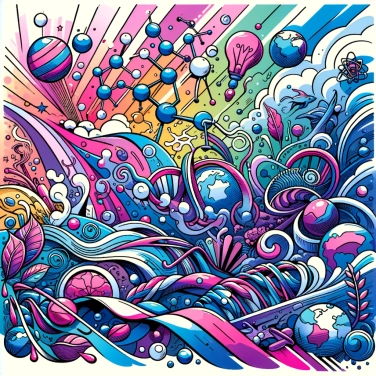The stars twinkle at night due to Earth's atmosphere. Atmospheric turbulence deflects the light from the stars, creating the twinkling effect that is observed from the surface of the Earth.

When the light from the stars reaches Earth, it must pass through our atmosphere, made up of several layers of air with varying temperatures and densities. These differences cause a sort of chaotic path for the light, which is constantly slightly deviated. As a result, the image of the star appears unstable and its brightness seems to change rapidly. This phenomenon creates what we observe from the ground as twinkling, somewhat like the stars are blinking quickly. The more turbulent the atmosphere, the more the star seems to twinkle. In the mountains, for example, the phenomenon is sometimes more noticeable because the cold and warm air mixes more there, enhancing these effects.
When the light from a star passes through our atmosphere, it goes through layers of air with varying temperatures and densities. This variation causes a refraction, essentially, the light ray slightly changes its path as it crosses these heterogeneous layers. Since our atmosphere is anything but calm, the light undergoes a multitude of rapid small deviations caused by atmospheric turbulence. As a result, the star appears to dance, it twinkles and sometimes even slightly changes color in our eyes. In short, the twinkling directly comes from these turbulences and the numerous refractions the starlight experiences before it reaches you.
The light of a star passes through layers of air with very varying temperatures before reaching your eyes. Each layer of air has its own density, which strongly depends on its temperature. The warmer the air, the lighter and less dense it is. Conversely, when it is cold, it becomes dense and heavy. When light moves from a warm layer to a colder layer (or vice versa), it slightly changes direction, a phenomenon called refraction. All these tiny and constant variations give the impression that the stars are vibrating or twinkling. The greater the temperature differences between air layers, the more you see the stars shimmering intensely.
The stars appear in the sky as infinitely small bright points, as they are so far away that we cannot distinguish their true size. As a result, their light arrives in the form of a tiny beam, very sensitive to atmospheric disturbances: this is why their brightness changes constantly. The planets, on the other hand, are much closer and are therefore perceived by the eye as small luminous disks. Their light comes from several rays, somewhat like a combination of many small beams. When the atmosphere disturbs one of these beams, the others compensate, reducing that famous twinkling. That is why planets usually have a stable light, without much flickering, while stars seem to blink incessantly.
The twinkling of stars has two origins: on one hand, the so-called intrinsic reasons directly concern the star itself, but they are rather rare for the twinkling observed with the naked eye. Some variable stars may experience small internal fluctuations in brightness, but this does not really explain the rapid flickering we notice in the sky.
The main cause of visible twinkling is therefore mostly extrinsic: it comes from the environment between the star and us. Specifically, it is almost always due to our terrestrial atmosphere, turbulent and capricious, which causes the light from stars to shimmer before it reaches our eyes. These external disturbances explain why stars shine like small hesitant beacons in the night sky.
The twinkling is all the more intense when the observed star is close to the horizon, as the light passes through a thicker and more turbulent layer of the atmosphere in that direction.
Unlike stars, planets twinkle very little because they are perceived as objects with a larger apparent surface in the sky. Their light is therefore less affected by atmospheric disturbances that are noticeable to our eyes.
In astronomy, using a space telescope in low Earth orbit allows scientists to completely avoid the effects of atmospheric twinkling, which is why the images from the Hubble Space Telescope are so sharp.
Although poetic, the twinkling of stars is problematic for ground-based astronomers, as it disrupts the precise observation of celestial bodies and often necessitates the use of special techniques such as adaptive optics to compensate for this phenomenon.
By conducting observations at high altitudes (mountains, high-altitude observatories) or in locations with stable atmospheric conditions, it is possible to significantly reduce the effects of scintillation. Furthermore, using telescopes equipped with adaptive optics systems allows for real-time correction of the effects of atmospheric turbulence.
No, generally planets twinkle much less than stars. Their extended rather than point-like appearance makes their light more stable as it passes through atmospheric turbulence.
No, the twinkling is mostly due to the Earth's atmosphere, so it is not observable from space. That's why astronauts see fixed and stable stars from the International Space Station.
Atmospheric turbulence can scatter the different colors of light from a star in various ways. This explains why some stars appear to change color as they twinkle, rapidly shifting from red to blue or white, for example.
Near the horizon, the light from the stars passes through a much thicker layer of atmosphere. This amplifies atmospheric disturbances and, consequently, enhances the phenomenon of twinkling.

No one has answered this quiz yet, be the first!' :-)
Question 1/6